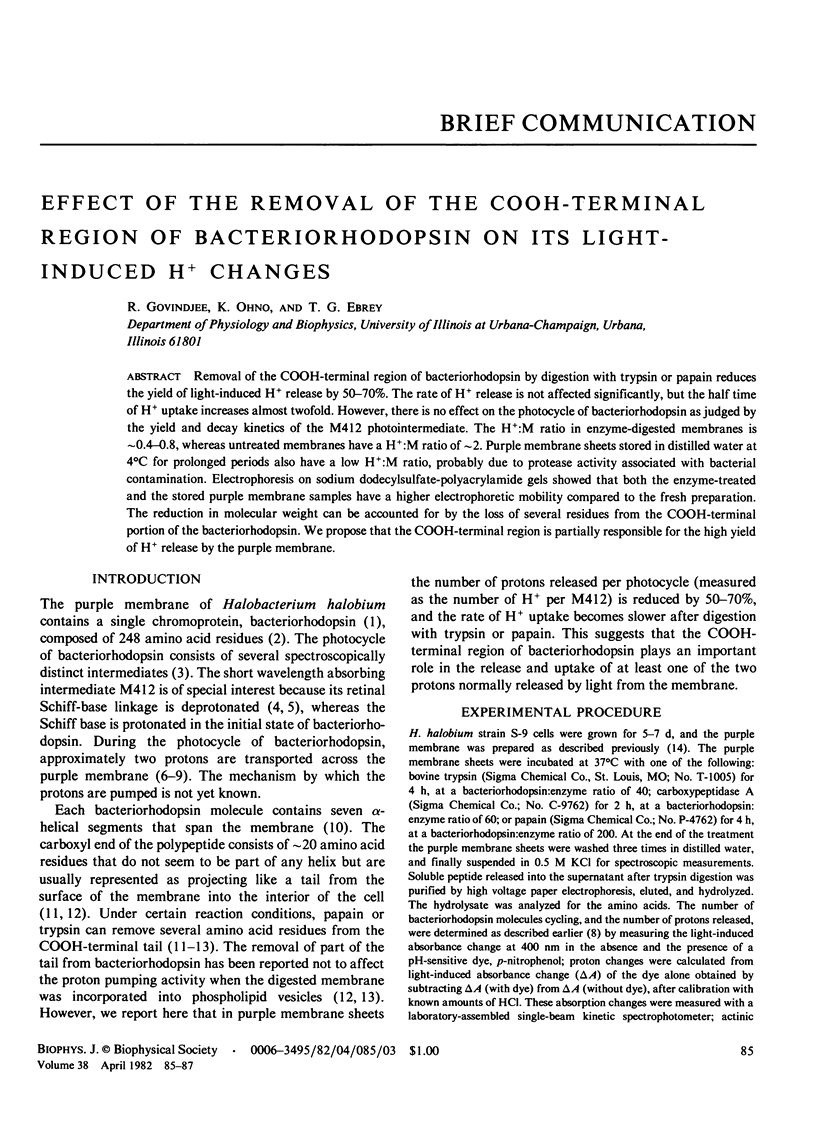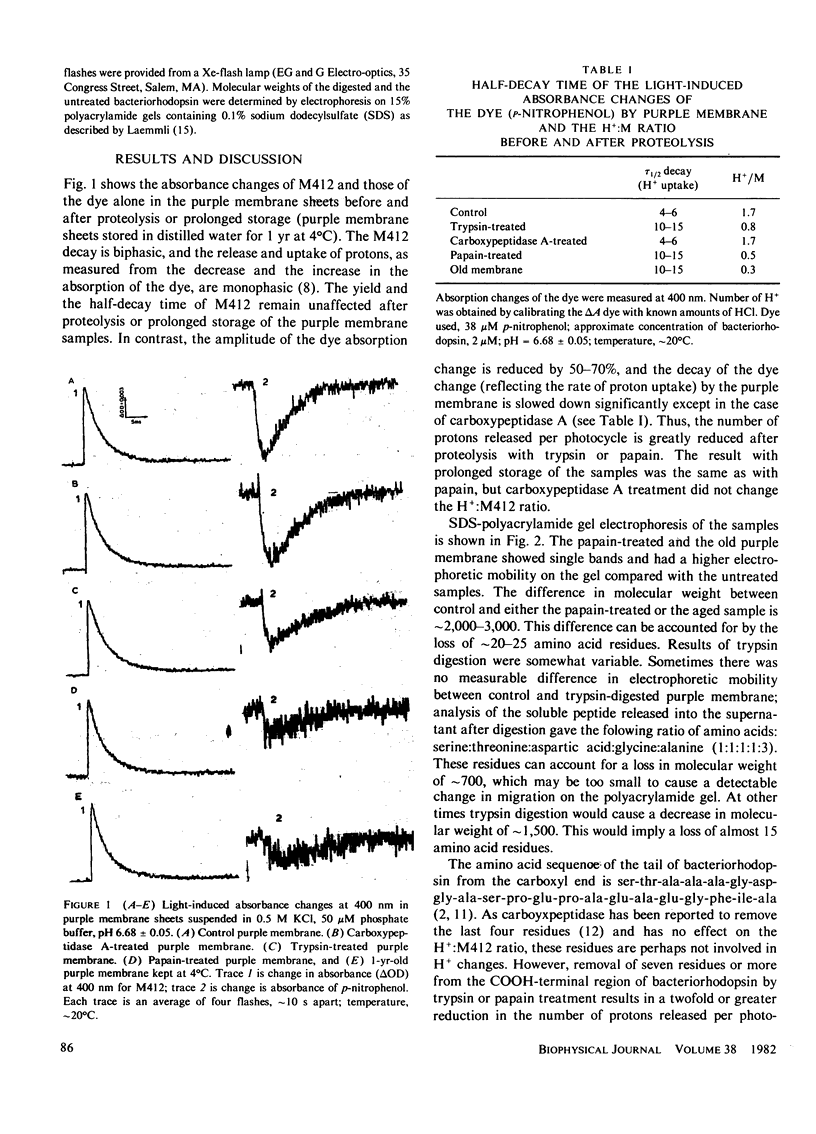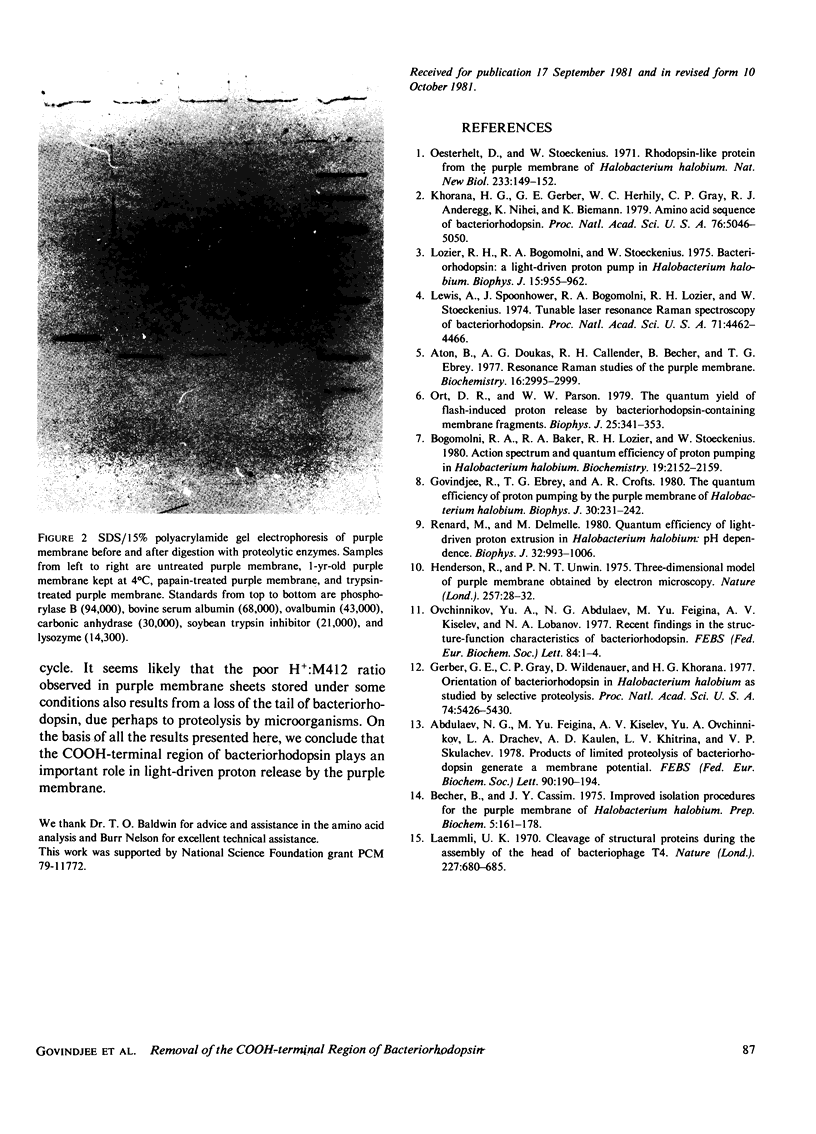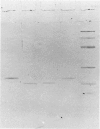Abstract
Removal of the COOH-terminal region of bacteriorhodopsin by digestion with trypsin or papain reduces the yield of light-induced H+ release by 50-70%. The rate of H+ release is not affected significantly, but the half time of H+ uptake increases almost twofold. However, there is no effect on the photocycle of bacteriorhodopsin as judged by the yield and decay kinetics of the M412 photointermediate. The H+:M ratio in enzyme-digested membranes is approximately 0.4-0.8, whereas untreated membranes have a H+:M ratio of approximately 2. Purple membrane sheets stored in distilled water at 4 degrees C for prolonged periods also have a low H+:M ratio, probably due to protease activity associated with bacterial contamination. Electrophoresis on sodium dodecylsulfate-polyacrylamide gels showed that both the enzyme-treated and the stored purple membrane samples have a higher electrophoretic mobility compared to the fresh preparation. The reduction in molecular weight can be accounted for by the loss of several residues from the COOH-terminal portion of the bacteriorhodopsin. We propose that the COOH-terminal region is partially responsible for the high yield of H+ release by the purple membrane.
Full text
PDF


Images in this article
Selected References
These references are in PubMed. This may not be the complete list of references from this article.
- Abdulaev N. G., Feigina M. Y., Kiselev A. V., Ovchinnikov Y. A., Drachev L. A., Kaulen A. D., Khitrina L. V., Skulachev V. P. Products of limited proteolysis of bacteriorhodopsin generate a membrane potential. FEBS Lett. 1978 Jun 15;90(2):190–194. doi: 10.1016/0014-5793(78)80366-4. [DOI] [PubMed] [Google Scholar]
- Aton B., Doukas A. G., Callender R. H., Becher B., Ebrey T. G. Resonance Raman studies of the purple membrane. Biochemistry. 1977 Jun 28;16(13):2995–2999. doi: 10.1021/bi00632a029. [DOI] [PubMed] [Google Scholar]
- Becher B. M., Cassim J. Y. Improved isolation procedures for the purple membrane of Halobacterium halobium. Prep Biochem. 1975;5(2):161–178. doi: 10.1080/00327487508061568. [DOI] [PubMed] [Google Scholar]
- Bogomolni R. A., Baker R. A., Lozier R. H., Stoeckenius W. Action spectrum and quantum efficiency for proton pumping in Halobacterium halobium. Biochemistry. 1980 May 13;19(10):2152–2159. doi: 10.1021/bi00551a024. [DOI] [PubMed] [Google Scholar]
- Gerber G. E., Gray C. P., Wildenauer D., Khorana H. G. Orientation of bacteriorhodopsin in Halobacterium halobium as studied by selective proteolysis. Proc Natl Acad Sci U S A. 1977 Dec;74(12):5426–5430. doi: 10.1073/pnas.74.12.5426. [DOI] [PMC free article] [PubMed] [Google Scholar]
- Govindjee R., Ebrey T. G., Crofts A. R. The quantum efficiency of proton pumping by the purple membrane of Halobacterium halobium. Biophys J. 1980 May;30(2):231–242. doi: 10.1016/S0006-3495(80)85091-0. [DOI] [PMC free article] [PubMed] [Google Scholar]
- Henderson R., Unwin P. N. Three-dimensional model of purple membrane obtained by electron microscopy. Nature. 1975 Sep 4;257(5521):28–32. doi: 10.1038/257028a0. [DOI] [PubMed] [Google Scholar]
- Khorana H. G., Gerber G. E., Herlihy W. C., Gray C. P., Anderegg R. J., Nihei K., Biemann K. Amino acid sequence of bacteriorhodopsin. Proc Natl Acad Sci U S A. 1979 Oct;76(10):5046–5050. doi: 10.1073/pnas.76.10.5046. [DOI] [PMC free article] [PubMed] [Google Scholar]
- Laemmli U. K. Cleavage of structural proteins during the assembly of the head of bacteriophage T4. Nature. 1970 Aug 15;227(5259):680–685. doi: 10.1038/227680a0. [DOI] [PubMed] [Google Scholar]
- Lewis A., Spoonhower J., Bogomolni R. A., Lozier R. H., Stoeckenius W. Tunable laser resonance raman spectroscopy of bacteriorhodopsin. Proc Natl Acad Sci U S A. 1974 Nov;71(11):4462–4466. doi: 10.1073/pnas.71.11.4462. [DOI] [PMC free article] [PubMed] [Google Scholar]
- Lozier R. H., Bogomolni R. A., Stoeckenius W. Bacteriorhodopsin: a light-driven proton pump in Halobacterium Halobium. Biophys J. 1975 Sep;15(9):955–962. doi: 10.1016/S0006-3495(75)85875-9. [DOI] [PMC free article] [PubMed] [Google Scholar]
- Oesterhelt D., Stoeckenius W. Rhodopsin-like protein from the purple membrane of Halobacterium halobium. Nat New Biol. 1971 Sep 29;233(39):149–152. doi: 10.1038/newbio233149a0. [DOI] [PubMed] [Google Scholar]
- Ort D. R., Parson W. W. The quantum yield of flash-induced proton release by bacteriorhodopsin-containing membrane fragments. Biophys J. 1979 Feb;25(2 Pt 1):341–353. doi: 10.1016/s0006-3495(79)85296-0. [DOI] [PMC free article] [PubMed] [Google Scholar]
- Renard M., Delmelle M. Quantum efficiency of light-driven proton extrusion in Halobacterium halobium. pH dependence. Biophys J. 1980 Dec;32(3):993–1006. doi: 10.1016/S0006-3495(80)85031-4. [DOI] [PMC free article] [PubMed] [Google Scholar]



